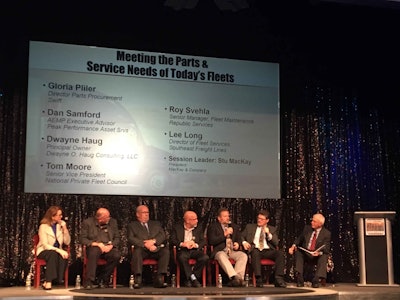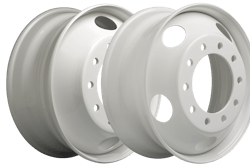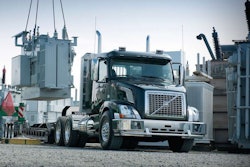 Panelists included from left: Gloria Pliler, director Swift parts procurement;
Panelists included from left: Gloria Pliler, director Swift parts procurement;Dan Samford, AEMP executive advisor, Peak Performance Asset Services; Dwayne Haug, Dwayne Haug Consulting; Tom Moore, senior vice president of National Private Fleet Council; Roy Svehla, senor manager of fleet maintenance for Republic Services; Lee Long, director of fleet services for Southeast Freight Lines
The technological sophistication of today’s trucks has presented carriers with a host of challenges, with some of them disguised as opportunities.
Tom Moore, senior vice president of National Private Fleet Council, notes that today’s trucks offer so much information that many of his membership’s fleets are turning that into actionable information.
Moore served as a fleet panelist at Heavy Duty Aftermarket Week in Las Vegas Monday looking at the parts and service needs of today’s fleets.
He notes a shift to predictive analytics and using data to manage best times to buy and sell equipment. “From a maintenance standpoint, they’re trying to get more life out of their equipment,” he says.
The volume of available of data can be overwhelming, and Moore says that has prompted many of his group’s members to outsource its maintenance. “Finding technicians is not easy,” he says, “and paying technicians has been a real challenge.”
Outsourcing, he adds, is not dependent on the size of the fleet. “It’s about what they see as a core capability.”
Gloria Pliler, Swift’s director of parts procurement, says the complexity of a truck’s electrical system has prompted her company to partner with dealerships nationwide. Swift has about 60 shops across the country and has placed dealer-employed technicians in many the company’s bays.
“It’s a challenge to find technicians,” she says. Pliler says Swift has struggled to retain techs, often losing them to dealerships.
“We’re still chasing trying to keep up with training,” adds Dwayne Haug, Dwayne Haug Consulting.
Pliler says Swift works with students at the high school level, helping get them get into tech schools and offers to mentor them in the company’s shops.
She says the computers so common in today’s service bays are also an attraction to the job for the younger generation.
“We have painted this as a dirty job,” Haug adds, “and we have to do something to change that.”
Opportunities lie beyond turning wrenches. Roy Svehla, senior manager of fleet maintenance for Republic Services, says in the last six years, his company has extended oil drain intervals more than 300 percent, while also shifting to a semi-synthetic blend, and changing from a 15-40 to 10-30.
Republic Services, he says, seeks to maximize the performance of modern oils, aided by the thermal efficiencies of today’s engines. “We’re trying to get the most for our oil dollar but we’re also trying to get the most for our equipment dollar,” he says.
Svehla has pushed his intervals to 900 hours to 1,350 hours, well past the OEM-recommended 300 hours, “with no problems whatsoever.”












